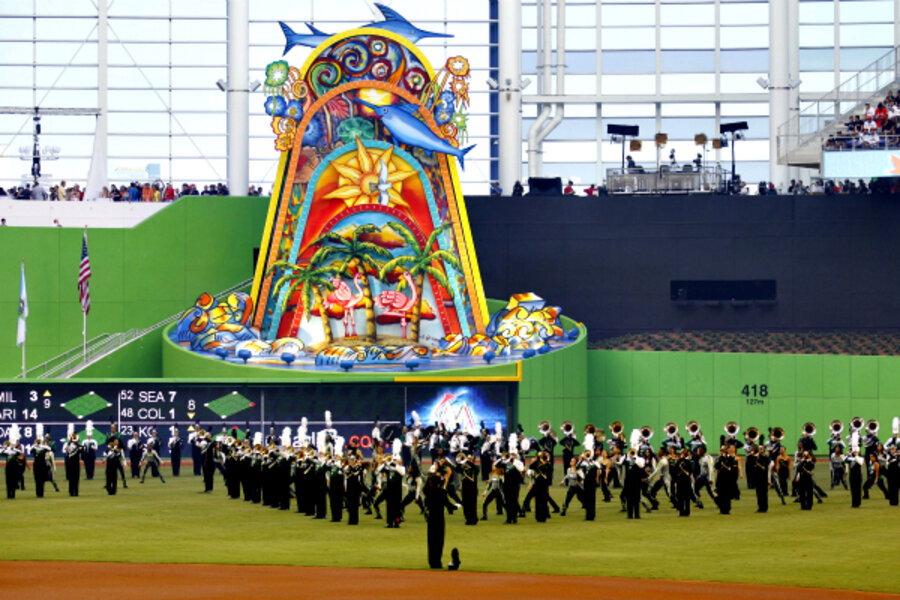Baseball proudly wears its green
Loading...
When millions of television viewers tune in to the Major League Baseball (MLB) All-Star Game Tuesday night (July 10), they’ll see something green at Kansas City’s 40-year-old Kauffman Stadium besides its carefully manicured field: a glistening bank of 120 solar panels.
The new panels are expected to produce 32,000 kWh of energy this year, the equivalent of the power used by three homes.
Baseball continues to be weighed down by a steroids scandal. While pitcher Roger Clemens won his recent court case, suspicions that he and many other former stars used performance-enhancing drugs remain, along with a heated debate over whether they should be allowed into baseball’s hall of fame.
RELATED: How student-built solar homes can help solve US housing and energy crisis
But while that dark spot lingers, a positive environmental spotlight on baseball grows brighter. Consider:
• The league’s newest stadium, built for the Miami Marlins and opened in April, is LEED certified (a rating bestowed by the US Green Building Council), in recognition of its green features. They include 249 waterless urinals that should save about 6 million gallons of water per year. Most of the building materials, including concrete recycled from the previous stadium, were harvested and manufactured locally to reduce transportation emissions.
Most of the construction waste also was recycled, and air-quality-friendly paints, adhesives, carpets, and flooring materials were used. Overall, the new ballpark is about 22 percent more energy efficient than a typical project of its size.
• This year Miami joins four other MLB ballparks in Milwaukee, San Francisco, Minneapolis, and Washington D.C. that have earned LEED certification.
• Besides the Kansas City Royals, solar panels have been installed in the home stadiums of the World Champion St. Louis Cardinals, the San Francisco Giants, the Colorado Rockies, the Boston Red Sox, the Arizona Diamondbacks, and the Cleveland Indians.
• Working with the Natural Resources Defense Council’s Sports Greening Project, in 2011 the Cardinals undertook a “4 a Greener Game” program that included a comprehensive energy audit. It found nearly 200 energy-saving improvements to make at Busch Stadium. The facility already has diverted more than 2,400 tons of material from landfills over the past four seasons by increasing recycling and composting.
• The Stadium Managers Association has created an annual Energy Bowl Competition among MLB teams. Together, the 30 teams have reduced their annual energy use by almost 50 million kBtu, enough energy to light 7,500 homes for a year. The Tampa Bay Rays won the top prize for 2011 by cutting stadium energy use by 16.6 percent during the year, largely by operating heating and cooling systems more efficiently. Target Field, home of the Minnesota Twins, and Nationals Park, home to the Washington Nationals, were runnersup, each cutting yearly energy use by more than 10 percent.
Many of the projects are double winners: They clean up the environment and cut energy costs as well.
While US baseball may be going green the fastest, other pro sports are jumping in too. Internationally, soccer’s 2014 FIFA World Cup, to be held in Rio de Janeiro, will feature a solar-powered stadium and other planet-friendly features.
Even NASCAR, the We-Love-the-Smell-of-Gasoline stock-car-racing circuit, is greening up. It’s partnering with the Environmental Protection Agency to encourage better practices among competitors and fans. NASCAR now promotes Design for the Environment-labeled products, such as safer chemicals, and it’s greening up the concession stands at NASCAR events, cutting water use, and encouraging recycling.
Baseball, America’s Pastime, is showing that sports entertainment and environmental responsibility can form a winning team. It’s past time that every sports league do the same.







